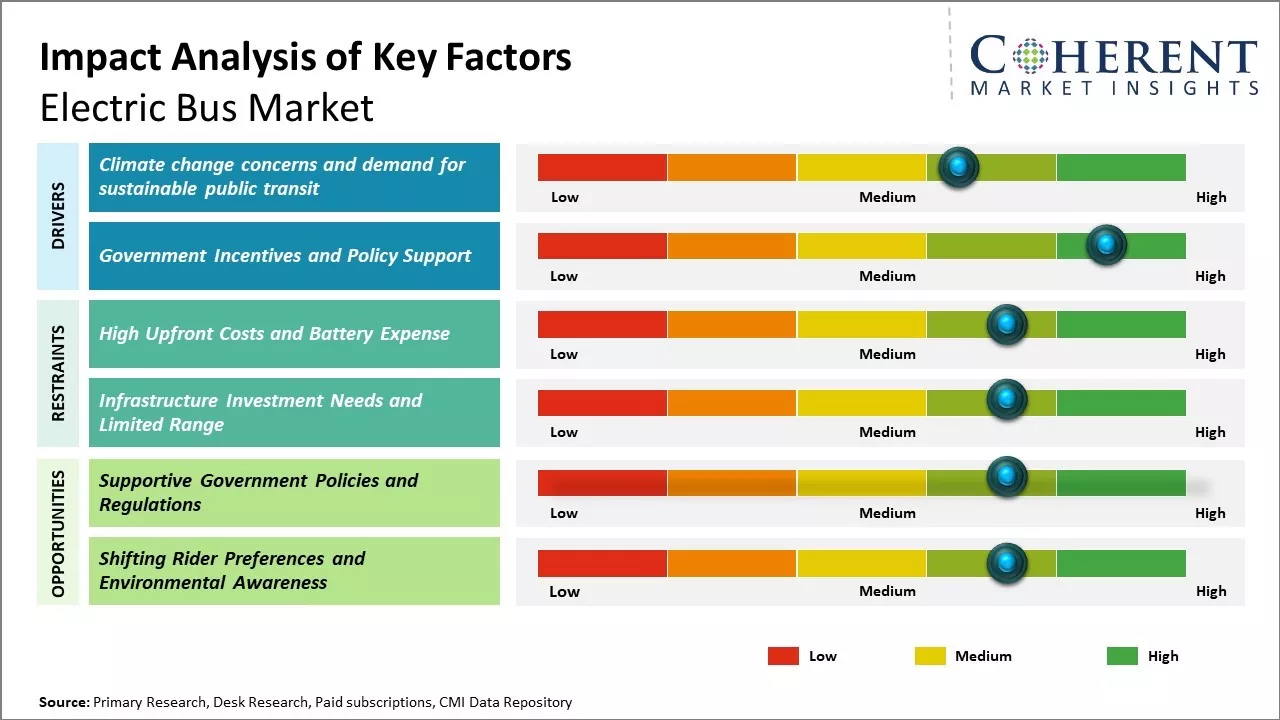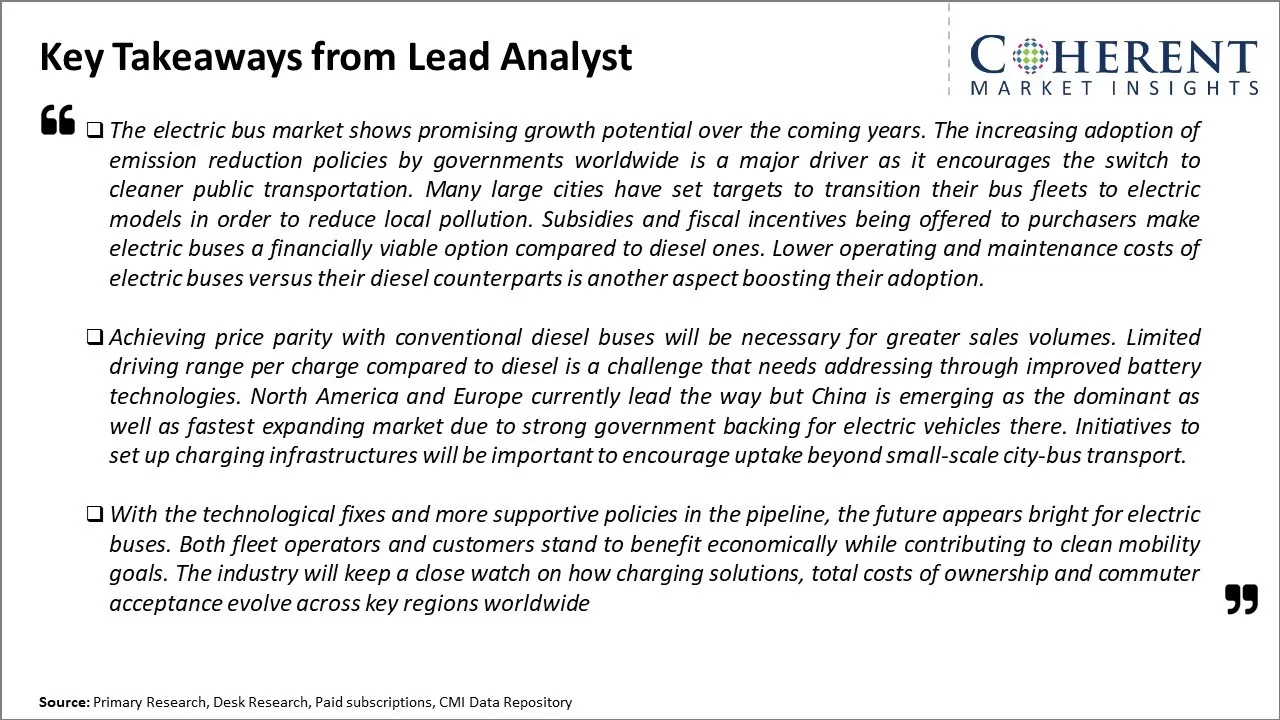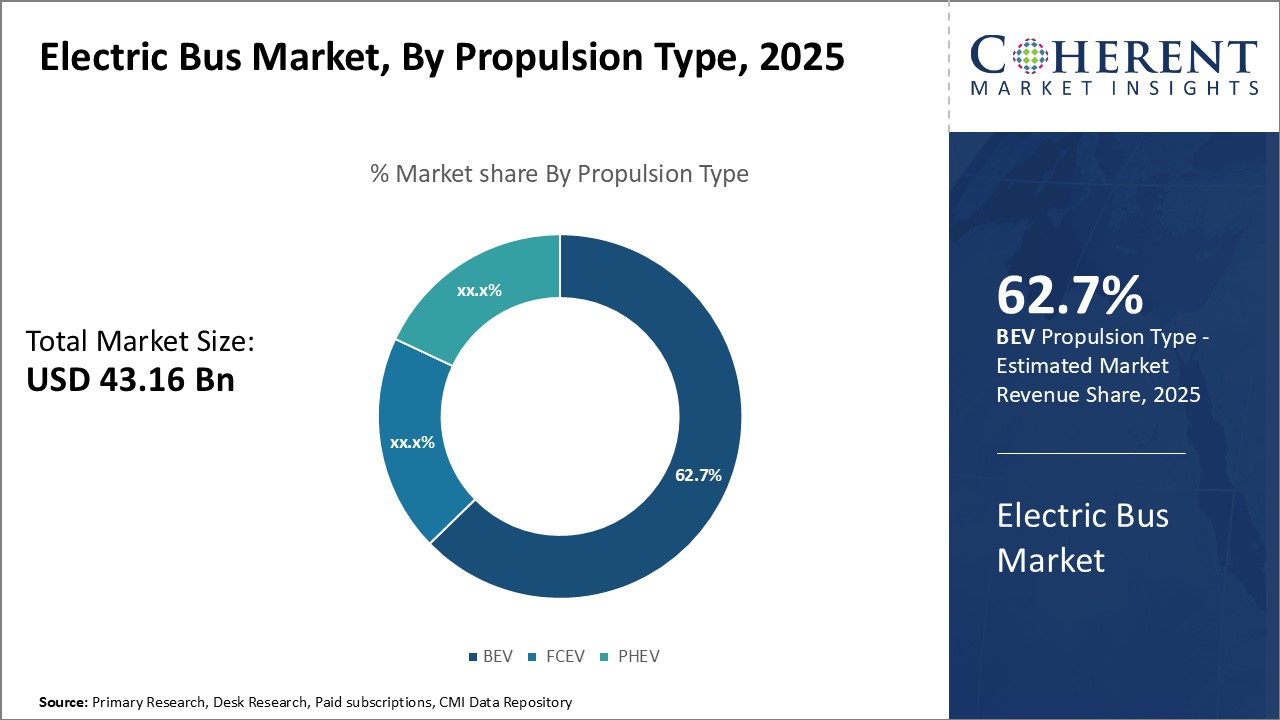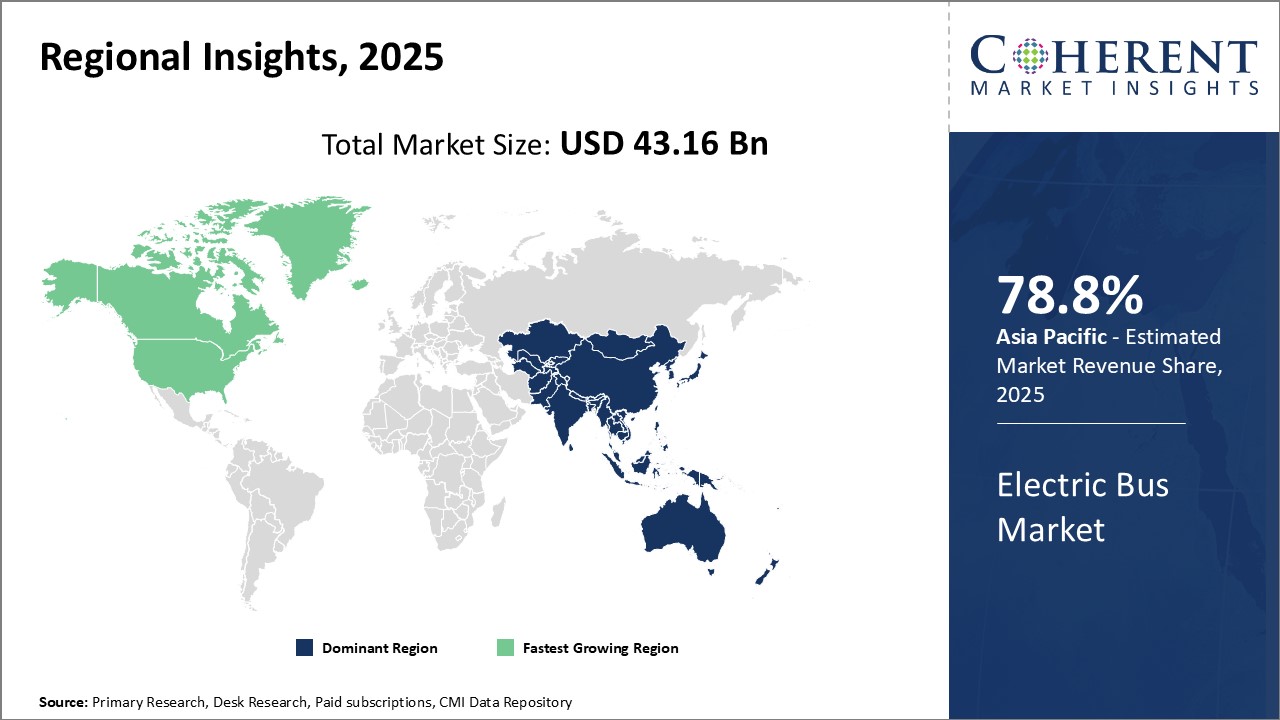The electric bus market is estimated to be valued at USD 43.16 Billion in 2025 and is expected to reach USD 127.30 Billion by 2032, growing at a compound annual growth rate (CAGR) of 16.7% from 2025 to 2032.

Discover market dynamics shaping the industry: Request sample copy
The electric bus market is driven by the need to reduce emissions from public transport. Major cities around the world are focusing on replacing their existing bus fleets with electric buses to improve the urban air quality. Countries are offering subsidies and promoting the adoption of electric buses. Bus manufacturers are launching new electric bus models with greater range to address consumer concerns. Also, lowering battery prices and advancing battery technologies are making electric buses more viable compared to diesel buses. Widespread charging infrastructure development by national governments will further accelerate this transition and drive the electric bus market in the coming years.
Climate change concerns and demand for sustainable public transit
As the impacts of climate change become increasingly visible and hard to ignore, governments, and public transit agencies around the world are under pressure to reduce carbon emissions from vehicular traffic. Buses form a crucial part of urban public transportation networks, and the conventional diesel buses that are most commonly used have significantly higher carbon footprint compared to electric buses. Many cities are major sources of air and noise pollution, and electric buses offer a cleaner, greener alternative to transition away from fossil fuel dependent mass transit. Public awareness about sustainability and corporate social responsibility is also on the rise. More companies and organization are committed to reducing their environmental impact, and promoting the use of electric vehicles as part of their efforts. Transit agencies have recognized that shifting to electric buses can help them gain goodwill from environmentally conscious citizens and demonstrate leadership in climate action. The zero-tailpipe emission of electric buses makes them especially appealing for public transportation in urban areas struggling with air quality issues. Concerns over worsening urban air pollution and public demands for a shift towards renewable energy are a major driver that is compelling more cities and public agencies to actively support electric bus adoption.
For instance, as of March 2022, China had over 421,000 electric buses in operation, constituting approximately 99% of the global electric bus fleet. Stringent government mandates, environmental considerations, and an expanding charging infrastructure are driving the electric bus market’s growth in Asia Pacific Region.

Get actionable strategies to beat competition: Request sample copy
Government Incentives and Policy SupportGovernments around the world are also incentivizing this shift through various subsidy and tax break programs for electric buses and related infrastructure. For example, the growing bus fleet electrification programs in Chinese cities were mainly driven by strong policy push and financial support from the national and local governments. The California marketplace for electric buses has also expanded rapidly over the past few years backed by massive grants and funding from the state. As emissions regulations get tougher worldwide, electric buses are emerging as a cost-effective means for transit agencies to transition to cleaner fleets and meet compliance standards. Their lower operating costs compared to diesel buses over the lifespan also make electric buses an attractive proposition for agencies aiming to maximize available budgets. With more automakers developing electric bus models, the options available to agencies are increasing as well. As battery technologies advance further, range limitations which were a challenge earlier are becoming less of a concern. All these factors combined are significant drivers that are fuelling the rising global demand for electric buses from a public transportation perspective.
For instance, in January 2023, the India-based electric mobility company, GreenCell Mobility Ltd, signed a contract with the transport department of the government of NCT Delhi. The agreement involves the deployment of 570 electric buses over the next two years. This move is driven by increasing population, environmental concerns, and a shift in consumer preference toward public transport.

To learn more about this report, Request sample copy
Market Challenges: High Upfront Costs and Battery ExpenseThe electric bus market faces several challenges. The upfront capital costs of electric buses are significantly higher than diesel buses, as battery and motor technologies remain expensive. Refueling and charging electric buses requires heavy infrastructure investments in grid upgrades and charging stations. Buses need to travel long distances daily, testing the limited range of current battery technologies. There are also concerns from operators regarding battery life and maintenance costs long-term. Standards and regulations for electronic components and charging are still evolving globally.
Market Opportunities: Supportive Government Policies and Regulations
Government policies around the world are increasingly supporting adoption through funding and regulations. Rider preferences are shifting towards more environmentally-friendly options. With larger scale manufacturing and technology improvements, battery and motor costs are expected to decline steadily. The total cost of ownership of electric buses is becoming comparable to diesel in many regions. City governments aim to reduce local emissions and fossil fuel dependency.

Discover high revenue pocket segments and roadmap to it: Request sample copy
Insights, By Propulsion Type- Technological advancement drives the demand for battery-powered buses
In terms of propulsion type, BEV is expected to contribute the highest share of 62.2 in 2025, owing to the advancements in battery cell technologies. BEVs offer greater ease of operation compared to other propulsion types as they do not require refueling infrastructure like hydrogen stations. Battery cell energy densities have improved considerably in recent years allowing BEVs to achieve longer driving ranges on a single charge. This increased range reduces range anxiety among transportation operators and makes BEVs more viable for inter-city routes. Continuous research by automakers has also brought down battery costs significantly, improving the total cost of ownership of BEVs. Governments around the world are providing strong subsidies for electric buses and setting targets for phasing out fossil fuel buses. Since BEVs do not emit any tailpipe emissions, they align well with the sustainability priorities of many cities and countries. The ZERO emissions of BEVs make them especially suitable for reducing pollution in densely populated urban centers.
Insights, By Length - Growing demand for medium-sized buses (9-14 meters)
In terms of length, the 9-14 meters segment is expected to contribute the highest share of 42.68% in 2025. Electric buses in this size range can accommodate sufficient passenger capacity while being more manoeuvrable than larger buses, well-suited for busy inner-city routes. The 9-14 meters size is optimal for high frequency intra-city and shuttle services. Many global cities are focused on electrifying public transit at scale to reduce urban air pollution. As bus fleets need large-scale replacements, the 9-14 meters segment serves as a sweet spot for achieving high electrification rates. Operators prefer medium-sized electric buses as they offer the right balance between capacity, size, and total cost of ownership compared to smaller or larger buses.
Insights, By Range- Short-range electric buses dominate early adoption
In terms of range, the less than 200 miles segment is expected to contribute the highest share of 82.76% in 2025. In the early phases of electric bus adoption, most fleet operators prioritize initial use cases focusing on shuttle and circulator routes within cities and between nearby towns. These intra-city routes typically involve daily ranges well under 200 miles, making shorter range buses sufficient. Shorter ranges also help ease operators' concerns over battery degradation and residual value. Many municipalities also face budget limitations in the initial procurement stages. Short-range electric buses with smaller battery packs offer a lower upfront cost compared to long-range options. As fleet operators gain more experience over time and battery technology progresses, the demand shift towards higher range buses will accelerate. But in the early growth phase, short-range buses are catalyzing the initial large-scale electrification of bus fleets.

Need a Different Region or Segment? Customize now
The global electric bus market is poised for substantial growth, with the Asia Pacific (APAC) region emerging as the primary driver. Projections for 2025 indicate that APAC is set to dominate the market, capturing an impressive 78.8% of the share and exhibiting the fastest growth rate at a CAGR of 18.82%. This dominance is underpinned by various factors, including robust government support in the form of financial incentives, regulatory initiatives, and infrastructure development projects aimed at promoting the widespread adoption of electric buses. Furthermore, the rapid economic growth and urbanization witnessed in the region contribute to an escalating demand for public transportation, creating a conducive environment for the proliferation of electric buses. The presence of major electric bus manufacturers, such as BYD in China, further positions APAC as a key player, offering a substantial advantage in terms of production capacity and technological advancements.
While Acia Pacific region commands the largest market share, other regions are also experiencing growth in the electric bus sector. In Europe, established public transportation systems, stringent emission regulations, and the presence of European electric bus manufacturers contribute to a steady growth rate ranging from 14-16.5% CAGR. North America is increasingly adopting electric buses in major cities, driven by a focus on reducing carbon footprints and improving air quality, leading to an anticipated CAGR of 15-18.5%. Latin America and the Middle East & Africa, although at an early stage of adoption with lower initial market shares, are projected to exhibit the highest CAGR, ranging from 19-25.5%. This growth is attributed to a growing awareness of environmental issues, potential government support, and significant room for expansion.
In summary, the electric bus market is on a promising trajectory, fuelled by a combination of supportive government policies, evolving consumer preferences, and continuous technological advancements. As the market evolves, regional dynamics may shift, with other regions potentially catching up to Asia Pacific as infrastructure development, government support, and technological progress continue to unfold.
Electric Bus Market Report Coverage
| Report Coverage | Details | ||
|---|---|---|---|
| Base Year: | 2024 | Market Size in 2025: | USD 43.16 Bn |
| Historical Data for: | 2020 To 2024 | Forecast Period: | 2025 To 2032 |
| Forecast Period 2025 to 2032 CAGR: | 16.7% | 2032 Value Projection: | USD 127.30 Bn |
| Geographies covered: |
|
||
| Segments covered: |
|
||
| Companies covered: |
AB Volvo, Alexander Dennis Limited, Anhui Ankai Automobile Co. Ltd., Ashok Leyland Limited, Blue Bird Corporation, Bolloré SE, BYD Company Limited, Daimler AG, Dongfeng Motor Company, Geely Automobiles Holdings Ltd., Hyundai Motor Company, Iveco S.p.A., New Flyer Industries Inc., Nissan Motor Corporation, Paccar Inc., Proterra Inc., Scania AB, Solaris Bus & Coach S.A., Tata Motors Limited, Toyota Motor Corporation, VDL Bus & Coach BV, Wrightbus Limited, Yutong Group, and Zhengzhou Yutong Bus Co., Ltd. |
||
| Growth Drivers: |
|
||
| Restraints & Challenges: |
|
||
Uncover macros and micros vetted on 75+ parameters: Get instant access to report
*Definition: The electric bus market involves the manufacturing and sales of battery-powered electric buses. Electric buses help reduce carbon emissions from public transportation and are more environment-friendly than diesel or compressed natural gas buses. Major components of electric buses include batteries, electric motors, charging infrastructure and vehicle control electronics. As concerns about air pollution and climate change rise, many cities and public transit agencies are transitioning their fleets to electric buses to lower operating costs while decreasing their carbon footprint.
Share
Share
About Author
Ameya Thakkar is a seasoned management consultant with 9+ years of experience optimizing operations and driving growth for companies in the automotive and transportation sector. As a senior consultant at CMI, Ameya has led strategic initiatives that have delivered over $50M in cost savings and revenue gains for clients. Ameya specializes in supply chain optimization, process re-engineering, and identification of deep revenue pockets. He has deep expertise in the automotive industry, having worked with major OEMs and suppliers on complex challenges such as supplier analysis, demand analysis, competitive analysis, and Industry 4.0 implementation.
Missing comfort of reading report in your local language? Find your preferred language :
Transform your Strategy with Exclusive Trending Reports :
Frequently Asked Questions
Joining thousands of companies around the world committed to making the Excellent Business Solutions.
View All Our Clients
US Reciprocal Tax Impact Analysis On Electric Bus Market
Stay updated on tariff changes with expert insights and timely information